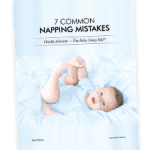
An older, wiser friend once told me, “Baby naps are God’s way of saying to parents, ‘I love you. Now go take a shower.’” Pretty accurate, right? Most parents look forward to naptimes. Ahhhh… Those brief interludes when you can actually pause for breath, do the never-ending chores, or have a little “me” time.
Of course, when it comes to naps, not all babies are created equal, are they? Some of you may have babies who are marathon nappers. They may even provide you with hours of uninterrupted time each day to shower and eat and pay bills and waste spend time on Facebook. Some of us, though, may not be so lucky. You may have a cat-napper who never sleeps for more than 30 or 40 minutes at a time. She may always seem to wake as cranky and exhausted as when she started too. And even if your baby’s sleeping through the night, short naps can still be frustrating, especially if you’ve worked hard for those 30-40 minutes putting baby down in the first place!
Some people recommend the “wake to sleep” method as a way to extend short naps. But does it work? Can your baby’s short naps be lengthened with this technique?
What is the “Wake to Sleep” Method?
Tracy Hogg first introduced the concept called “wake to sleep” in her book Secrets of the Baby Whisperer: How to Calm, Connect, and Communicate With Your Baby. Tracy suggests in her book that a number of babies who wake frequently at naptime and at night are habitual wakers. That is, they’re waking out of habit, and not out of hunger or distress. According to Tracy, habitual wakers tend to wake at roughly the same time each night, and they tend to wake from their naps about 30 or 40 minutes after falling asleep.
Does this sound like your baby? If so, she may be a habitual waker. This would explain why her naps are so short, why she often wakes up tired and cranky, and why you just can’t get her on a nap schedule. She’s waking out of habit, and not because she’s actually had enough sleep. It’s not a coincidence, however, that it’s 30 to 40 minutes later. Your baby may not be able (yet) to transition to her next sleep cycle without your help, or she may not expect to be required to do it on her own. She wakes 30-40 minutes because that’s how long her sleep cycle is and some people can set a clock to it!
It’s important to remember that the “wake to sleep” method is used to solve the problem of habitual waking. Before using this method, it’s important to make sure that your baby isn’t waking out of hunger, illness, or discomfort. If you’ve ruled out those causes, however, it’s safe to try the “wake to sleep” method.
How You Can Use the “Wake to Sleep” Method to Lengthen Naps
The idea behind “wake to sleep” is that you’re “supporting” your child through the transition from one sleep cycle to the next. The first 20 or so minutes of a nap are light sleep, or REM sleep. After that, baby transitions into deeper, or non-REM, sleep. It’s during that transition period that babies often wake and aren’t able to get back to sleep.
With the “wake to sleep” method, you lightly rouse your baby (rubbing his back, making shushing sounds, gently tickling his feet, stroking his hair, or simply turning on the light and whispering his name, if he’s a light sleeper) before he begins that transition, and then you help him make the transition, gently easing him into the next stage of deeper sleep.
Should You Use the “Wake to Sleep” Method to Lengthen Naps?
At The Baby Sleep Site, we do our best to empower parents in their sleep training decisions and to remain judgment-free when it comes to offering advice. “Wake to sleep” is obviously a very gentle method that would support a no-cry sleep training philosophy. If you’re a parent with a very young (or newborn) baby, or if you have a strong aversion to any amount of crying, “wake to sleep” might be a good option for you to try. (It doesn’t typically hurt to try!) In those early months (when it’s too soon to begin formal sleep training, but you’re so tired you feel like you might fall asleep driving your precious cargo around), it helps to have every tool available in your toolbox!
One recent client shared with us that she successfully used this method with her son when he was 2 or 3 months old. (Before seeking our help with her nighttime issues.) He was waking from his naps after exactly 45 minutes of sleep. She said this:
“At the 40 minute mark, I would gently jiggle his Pack and Play so that he would transition from one sleep cycle into the other. I did this for a couple of weeks and it worked. Now, he rarely wakes at the 45 minute mark.”
For her, “wake to sleep” was a nice solution to her problem, especially since her son was still too young for formal sleep training. The “wake to sleep” method can be a good way to help your newborn nap longer.
Although this method works for some families, we generally don’t recommend using the “wake to sleep” method as a way to extend short naps. First, it is risky in that you may inadvertently wake the baby you’ve worked hard at getting to sleep! And, if your baby is anything like Nicole’s, the moment he saw you there, he’d be up! Second, if your baby is taking short naps due to a schedule problem, wake to sleep likely won’t work.
And finally, we don’t want to help our babies create any sleep associations that involve lots of work on our part, whether it’s rocking or nursing the baby to sleep, replacing a pacifier every 15 minutes, or easing the baby through every transition between sleep cycles. Ultimately, the goal is for your baby to learn to fall asleep and stay asleep by herself. Of course, all babies (and parents!) are different. What you mind “doing” at nap time, and how often you do it, will differ from another parent.
Furthermore, many people acknowledge that while “wake to sleep” can work, the results aren’t necessarily permanent, since you aren’t teaching the baby any new habits. You’ve probably heard the old saying, “Give a man a fish and feed him for a day. Teach a man to fish and feed him for life.” This same principle holds true for many parents using “wake to sleep” to lengthen naps. The “wake to sleep” method may help you extend today’s nap(s), but teaching a baby good sleep habits will likely mean good naps every day.
How To Help Your Baby Take Better, Longer Naps (Once And For All!)
 Short or non-existent baby naps can be so frustrating! But you don’t have to suffer through them any longer! We have a ton of nap resources. One of those nap resources is our free guide, 7 Common Napping Mistakes. Are you making any of these common nap mistakes? If so, they may be the cause of your baby’s too-short naps. So download your free guide today, and start putting the tips to use as early as your baby’s next nap!
Short or non-existent baby naps can be so frustrating! But you don’t have to suffer through them any longer! We have a ton of nap resources. One of those nap resources is our free guide, 7 Common Napping Mistakes. Are you making any of these common nap mistakes? If so, they may be the cause of your baby’s too-short naps. So download your free guide today, and start putting the tips to use as early as your baby’s next nap!
Special VIP Members-Only Nap Resources
 Mastering Naps & Schedules — For starters, all Baby Sleep Site® VIP members receive unlimited access to all our e-Books. That’s right! For the price of your VIP membership, you can read all our e-Books at no additional cost!
Mastering Naps & Schedules — For starters, all Baby Sleep Site® VIP members receive unlimited access to all our e-Books. That’s right! For the price of your VIP membership, you can read all our e-Books at no additional cost!
This includes Mastering Naps & Schedules. With over 45 sample schedules (all available for you to read in the VIP Members Area), Mastering Naps & Schedules is THE e-Book for tired parents of non-napping kiddos! We tackle all your top napping issues! Topics include how to get your baby or toddler to take longer naps, how to get your child’s naps to be more consistent and predictable, how to manage nap transitions, how to encourage good napping while traveling – and more! Become a VIP member today, and access the e-Book instantly. No download necessary!
 Nap Audio Courses — Another great VIP members-only resource? Our audio courses. Hosted by Nicole herself! These audio recordings offer you insider information and our trademark sleep coaching philosophies, methods, and techniques. We have several awesome nap-focused audio courses, including one that’s all about lengthening naps! Listening to these mini-courses is like getting a coaching session from Nicole! She’ll walk you through the basics of dealing with common nap problems and give you tried-and-true strategies you can implement at home.
Nap Audio Courses — Another great VIP members-only resource? Our audio courses. Hosted by Nicole herself! These audio recordings offer you insider information and our trademark sleep coaching philosophies, methods, and techniques. We have several awesome nap-focused audio courses, including one that’s all about lengthening naps! Listening to these mini-courses is like getting a coaching session from Nicole! She’ll walk you through the basics of dealing with common nap problems and give you tried-and-true strategies you can implement at home.
For more details about all our VIP member benefits, visit our membership page. Consider becoming a VIP member today!








